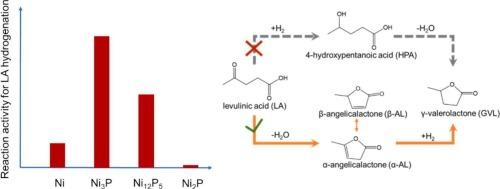Ni3P/MCM-41催化剂上生物质衍生乙酰丙酸高效水相加氢制γ-戊内酯:磷修饰和反应途径的关键作用
IF 7.5
1区 工程技术
Q2 ENERGY & FUELS
引用次数: 0
摘要
乙酰丙酸(LA)的水相加氢生成γ-戊内酯(GVL)是生物质增值的关键。为了满足对高效稳定催化剂的需求,我们开发了p改性Ni/MCM-41催化剂。重要的是,精确控制Ni:P比控制特定Ni-P相的形成,这直接决定了催化活性。最优Ni3P相(Ni:P = 3:1)在温和条件下(80°C, 10 h)获得了100%的GVL产率,显著优于过量P形成的非活性Ni2P。综合表征表明,P增强了Ni的色散,并通过Ni→P电荷转移诱导了缺电子态(Niδ+)。原位FTIR和吸附研究证实了LA在Ni3P上的优先吸附,并确定当归内酯为关键中间体,从而阐明了促进选择性加氢而非副反应的反应途径。Ni3P/MCM-41催化剂在四个周期内保持了活性。这项工作建立了基本的结构-活性关系,并强调了精确的Ni-P相控制作为可持续催化的关键设计策略。本文章由计算机程序翻译,如有差异,请以英文原文为准。

Highly efficient aqueous-phase hydrogenation of biomass-derived levulinic acid to γ-valerolactone over Ni3P/MCM-41 catalyst: The critical role of phosphorus modification and reaction pathways
The aqueous-phase hydrogenation of levulinic acid (LA) to γ-valerolactone (GVL) is crucial for biomass valorization. To address the need for efficient and stable catalysts, we developed P-modified Ni/MCM-41 catalysts. Importantly, precise control of the Ni:P ratio governs the formation of specific Ni-P phases, which directly determines catalytic activity. The optimal Ni3P phase (Ni:P = 3:1) achieved 100 % GVL yield under mild conditions (80 °C, 10 h), significantly outperforming the inactive Ni2P formed with excess P. Comprehensive characterization revealed that P enhances Ni dispersion and induces an electron-deficient state (Niδ+) via Ni → P charge transfer. In situ FTIR and adsorption studies demonstrated preferential LA adsorption on Ni3P and identified angelica lactones as key intermediates, thereby elucidating the reaction pathway that promotes selective hydrogenation over side reactions. The Ni3P/MCM-41 catalyst-maintained its activity over four cycles. This work establishes fundamental structure–activity relationships and highlights precise Ni–P phase control as a critical design strategy for sustainable catalysis.
求助全文
通过发布文献求助,成功后即可免费获取论文全文。
去求助
来源期刊

Fuel
工程技术-工程:化工
CiteScore
12.80
自引率
20.30%
发文量
3506
审稿时长
64 days
期刊介绍:
The exploration of energy sources remains a critical matter of study. For the past nine decades, fuel has consistently held the forefront in primary research efforts within the field of energy science. This area of investigation encompasses a wide range of subjects, with a particular emphasis on emerging concerns like environmental factors and pollution.
 求助内容:
求助内容: 应助结果提醒方式:
应助结果提醒方式:


